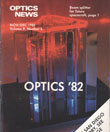
November, 1982 Issue
Feature Articles
The scanning laser ophthalmoscope (SLO) has made it possible to present a view of the inside of the eye as a television image—accessible to computer manipulation—while actually decreasing the light falling on the sensitive retina during examination. At the Eye Research Institute of the Retina Foundation in Boston, Robert Webb and George Hughes have used lasers and electronics to turn the conventional instrument inside out.
by Robert W. MassofOptical processing in radon space
The Radon transform is the mathematical basis of computed tomography. In this important medical imaging technique, the basic data are a set of one-dimensional (ID) projections of a 2D object, obtained by integrating it along a set of lines. The projection process is called the 2D Radon transform, and reconstruction of the object from its 1D projection is an implementation of the 2D inverse Radon transform.
by Harrison H. BarrettA supermarket scanner reads the Universal Product Code (UPC) bar code symbol appearing on grocery items. The scanner uses the red light from a Helium-Neon laser and some means to deflect or scan the laser beam across the symbol as it passes across a window or aperture in the top surface of the scanner. A detector within the scanner senses the variations in reflected laser light as the laser beam scans across the symbol. These variations are converted to an electrical signal which is decoded to identify the product.
by Glenn T. SincerboxOptical bistability at room temperature
Optical bistable devices may someday be the key elements of all-optical logic and computing systems. Semiconductor devices appear particularly promising because of very large optical nonlinearities permitting the construction of very small devices. The goal is to develop small (~ 1μm), fast (~1ps), low-power (~1μW), high-temperature (~300 K) devices. Herein is reported room-temperature operation of a GaAs super-lattice device which is very similar in size, speed, and power to the low-temperature pure GaAs device.
by H. M. Gibbs, S. S. Tarng, J. L. Jewell, D. A. Weinberger and K. TaiThe Microfabrication group at Bell Labs — Holmdel, N.J., has developed techniques for making electronic devices with minimum dimensions of 1000 Angstroms or smaller. These devices have been used to study fundamental quantum noise, one-dimensional quantum conduction and the ultimate limits of microelectronics.
by R. E. Howard and L. D. Jackel,

![Manual probe system with needles for test of semiconductor on silicon wafer. [A. Morozov / Getty]](https://opnmedia.blob.core.windows.net/$web/opn/media/images/articles/2025/1125/departments/202511-cover-web.jpg?ext=.jpg)
![Researcher Clara Saraceno in the lab. [Image by Carsten Behler Photography]](https://opnmedia.blob.core.windows.net/$web/opn/media/images/articles/2025/1025/departments/202510-cover-web.jpg?ext=.jpg)
